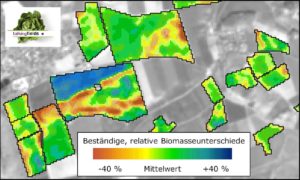In the right place at the right time. And also in the right quantity for the optimal yield. This is exactly what becomes possible when smart farming technology that is ideally adapted to subareas is used for the cultivation of agricultural land. As part of a two-year project carried out in cooperation with nine participating project farmers, we were able to build up know-how and practical experience for the Lagerhaus and RWA network in the area of the sowing and N-fertilisation of grain maize.

The “Subarea Pilot Project”, which focuses on the subarea-specific (variable rate) cultivation of grain maize, was launched in autumn 2017. The TalkingFields base map (TF base map) was used as the basis for adjusting the sowing density and quantity of N-fertiliser in each subarea. Satellite data gathered over several years shows that this has led to consistent, relative biomass differences and allows conclusions to be drawn about the distribution of yield and soil quality on the plot. Application maps with a resolution of 10 x 10 m were created on the basis of this data.
Experimental setup
In addition to variant 0 with a homogeneous output quantity, variants A, D and AD were also created:
– Variant A: Variation of the sowing density
– Variant D: Variation of the quantity of N-fertiliser
– Variant AD: Variation of the sowing density and the quantity of N-fertiliser
The total area under grain maize cultivation amounted to approx. 100 ha per trial year, distributed over about ten fields. The most widely used variety of maize was DieSONJA and the most widely used N-fertiliser was the stabilised fertiliser ALZON® neo-N.
Technology for the subarea
A 6155R John Deere tractor, an eight-row Monosem precision air seeder and a Rauch Axis fertiliser spreader were used in the project. All machines were ISOBUS-compatible and had the TC-GEO certification required for site-specific cultivation. The technical implementation of site-specific cultivation within the framework of the project was very satisfactory. Particular attention must be paid to the compatibility of the software versions of the individual machines.
Test results
Taking the average of both years, Variant A achieved an additional yield of approx. 3.3 per cent while Variant D only achieved an additional yield of approx. 1.7 per cent. The combined variant achieved an average additional yield of 3.4 per cent. In some areas of the trial, additional yields in the range of 5 to 7 per cent were also achieved.
Conclusions
In some cases, the yield responded very well to variations in the sowing density during the project. Varying the amount of N-fertiliser in grain maize also had some effect in the same year, but less effect than varying the sowing density. In any event, subarea-specific fertilisation should be considered over several years, ideally with the support of zoned soil sampling.
The basis for the success of subarea-specific cultivation is the systematic development of a sound database for the individual fields of a farm. On the basis of this data, specific application maps can be created for each of a range of applications.
Photo news overview page: RWA, Robert Gebauer
Photo in article: Vista Ltd
